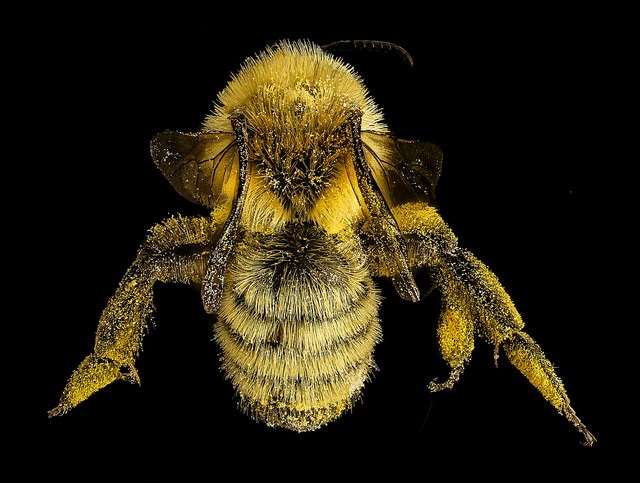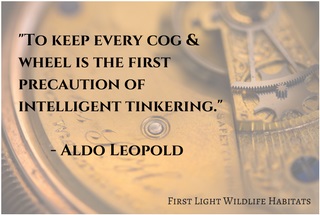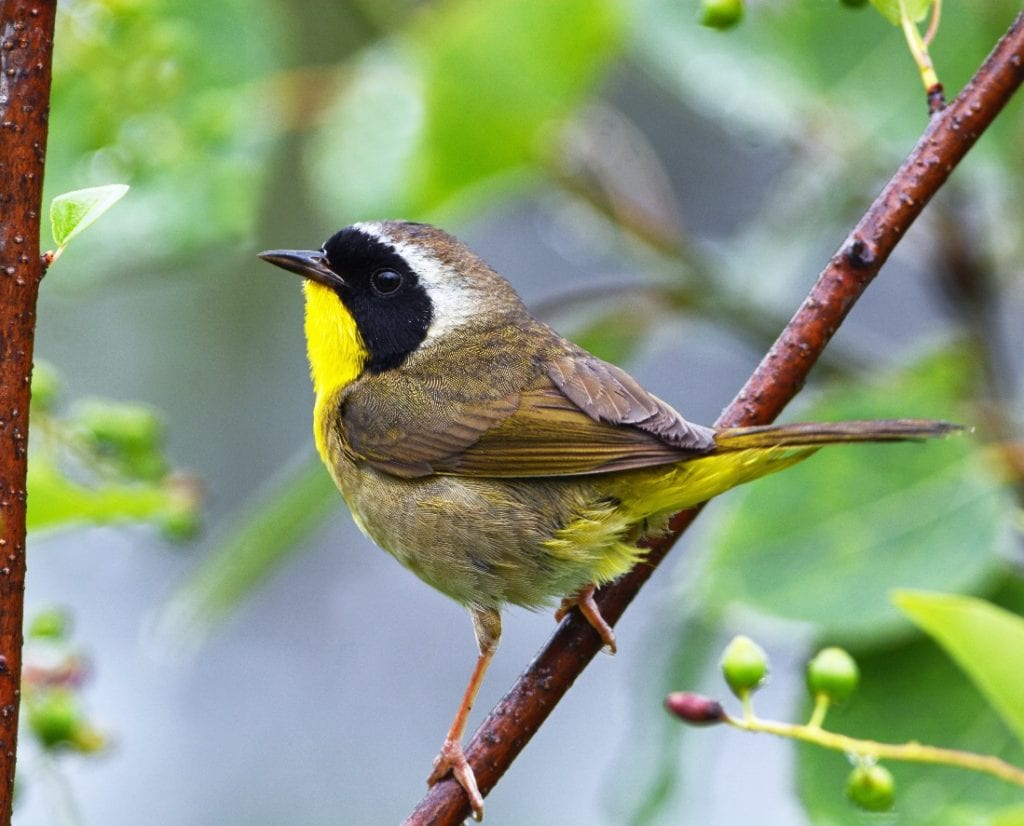“To keep every cog and wheel is the first precaution of intelligent tinkering.”
— Aldo Leopold, 1949
In my last blog post, I wrote about Aldo Leopold (the father of wildlife ecology), carnivore coexistence, and his “thinking like a mountain” quote. This follow-up post springs from another one of his well-known quotes, and explores the importance of biodiversity and how you can promote biodiversity on your own patch of ground, no matter the size.
Why Biodiversity Matters
Biodiversity is a bit of a buzz word and can be an abstract concept, often thought of on more of a global scale, or in association with rainforests or coral reefs.
So, let’s get really clear on what biodiversity actually means and how we can apply it to the scale of our gardens, yards, and larger properties here in northern New England.
In plain terms, biological diversity is the variety of living things — the variety of plants, animals, and natural communities.
Biodiversity also includes things like genetic diversity, and more genetic diversity makes extinction of species less likely because species have a larger pool of genes and can better respond to changes in their environment.
Biodiversity is key to ecosystem function and resilience because diversity in nature allows for more flexibility, adaptation, and stability.
Variety in nature supports key ecological processes, such as pollination for example. We have over 270 species of native bees in Maine alone (the honeybee that gets so much attention is not native to North America). In Maine, this highly diverse group of insects includes the sweat bees, plasterer bees, mining bees, mellitids, bumble bees, leafcutters, and mason bees. Collectively they pollinate countless wild and cultivated plants across our region. Without their critically important services, those plants could not reproduce, or provide us with valuable food. Scientists estimate that three out of every four mouthfuls of the food and drink we consume is brought to us by pollinators.
As “keystone species” bees play a critical role in upholding the integrity, productivity, and sustainability of a forest understory, pasture, field, meadow, farm, orchard, or backyard garden.
According to The Xerces Society for Invertebrate Conservation, fruits and seeds derived from insect pollination are a major source of food for many species of birds and mammals.
To learn more about native bees and other pollinators join us at an upcoming event.
As I explained in my last blog post, in relation to carnivores, keystone species are critically important to the balance of an ecosystem.

A mining bee (Andrenid) collected on goldenrod in Maine. Note the abundance of pollen over the hairy body of the entire bee (photo: USGS bee inventory on Flickr).
Ecosystems can better handle stress when all the parts are functioning together. As the World Wildlife Fund explains biodiversity, try thinking of each species as a single thread, and the more threads that link together, the stronger the safety net will be.
All the inter-connected parts, their relationship to each other and their unique functions, create a more stable and resilient system.
Overall, biodiversity forms our life support system – and is responsible for our very existence.
“Intelligent Tinkering”: Habitat Design
Biodiverse landscapes are more resilient in the face of climate change, disease, extreme weather events, alien species invasions, and other stressors. Aldo Leopold said it well, when he wrote that “To keep every cog and wheel is the first precaution of intelligent tinkering.”

Since the industrial revolution we have heavy-handedly “tinkered” with the natural world in the most unconscious, haphazard way.
As a result, our wildlife communities are struggling and their habitats increasingly degraded and fragmented.
On the whole, wild ecosystems have checks and balances built in for stability, but because of all the human-related threats and stressors acting on them, they are in need of our help.
We must actively manage our landscapes to counteract and mitigate these often-devastating effects.
As landowners, how do we enhance habitat and help put the pieces back together? Well, the good news is that you can conserve nature right where you are, at any scale.
Whether you have a small garden or yard, a field or farm, a forest, or a business or college campus: there are practical things you can do right now that can boost biodiversity and support struggling wildlife populations, like native bees and songbirds.
Every shrub, plant, and micro-habitat can make a difference.
Armed with the right tools and knowledge, we can intelligently tinker to restore the health of our ecosystems and secure a more stable future for wildlife – from bees to bears, and everything in between.
I call my work “habitat design” because it is designed to benefit wildlife. The work is highly intentional with the primary objective being to enhance habitat for birds, pollinators, mammals – whatever focal species the client is interested in attracting and benefitting.

The Common Yellowthroat is found in a wide range of habitats including thickets, wet marshy areas, and edges (see #3, below). The population has declined 38% since the mid-60s (photo: Doug Gimler www.nekwildlifephoto.com).
How to Boost Biodiversity at Home
1) Plant a diversity of native flowering plants. Plants are the basis for habitat because they support insect populations, which in turn support all other forms of life in our backyards and wooded properties. Most insects can only use plants that they co-evolved with (i.e., native plants). If your goal is to support wildlife – native plants are the way to go. For more about this, as well as tips for sourcing plants, see my last newsletter: Plan Your Habitat Garden.
2) Remove and regularly monitor your land for invasive plants. Non-native, invasive plants can take over natural areas, are aliens on the landscape, and don’t function in the ecosystem like native plants do (for example, they don’t support insect life). They are a major threat to biodiversity. For more information see my blog post Invasive Plants: A Top Threat to Biodiversity.
3) Promote and enhance edge habitats. Field-forest edges are valuable wildlife habitats. These transitional zones are generally beneficial to wildlife, but “hard” or abrupt edges are not natural – they are a construct of human land management. Hard edges don’t provide good escape cover for prey, and predators can exploit these unnaturally abrupt edges. High quality edges are those that gradually transition from grasses to shrubs to vines, to small trees, and then to large trees in a large border of vegetation around a field. These are known as “soft” or “feathered” edges. Helping landowners create and enhance edge habitat is one of my specialties. Work with me to get customized recommendations (on-site consultation) and/or a detailed habitat design package for your specific situation.
There are many other ways you can boost biodiversity on your home landscape.
I would be delighted to partner with you to build a beautifully biodiverse place that reflects your values and provides wildlife with the special places they need to nourish themselves, stay safe, and raise young.
You can provide all of this to wildlife, right where you are, and at any scale. You can begin right now. It’s easier than you think.
Did you know? The economic value of the pollination services of native bees in the U.S. alone is estimated at $3 billion.
Sometimes protecting the earth can seem overwhelming. But there are things people can do in their own yard to make the world a better place for native wildlife. Deborah Perkins shares her 25 years of knowledge and experience with readers of this blog. The tips she provides here are just a small sampling of what she provides to clients interested in creating habitat for birds, bees, butterflies, and other wildlife. Visit her First Light Wildlife Habitats for more information about how Deb can help you enhance your property for the benefit of native wildlife.










Leave a Reply